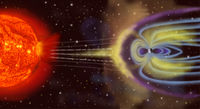
Photo from wikipedia
Abstract. The comparative research of the influence of different types of auroral particle precipitation and polar cap patches (PCPs) on the global positioning system (GPS) signals disturbances in the polar… Click to show full abstract
Abstract. The comparative research of the influence of different types of auroral particle precipitation and polar cap patches (PCPs) on the global positioning system (GPS) signals disturbances in the polar ionosphere was done. For this purpose, we use the GPS scintillation receivers at Ny-Ålesund and Skibotn, operated by the University of Oslo. The presence of the auroral particle precipitation and polar cap patches was determined by using data from the EISCAT 42m radar on Svalbard. The optical aurora observations in 557.7 and 630.0 nm spectrum lines on Svalbard were used as well for the detection of ionospheric disturbances. The cusp identification was done with using SuperDARN (Hankasalmi) data. We consider events when the simultaneous EISCAT 42m and GPS data were available for the years 2010–2017, and in this paper we present, in detail, typical examples describing the overall picture, and we present the statistics for 120 events. We considered the dayside/cusp precipitation, substorm precipitation, daytime and nighttime PCPs, and precipitation associated with the interplanetary shock wave arrival. We demonstrate that substorm-associated precipitation (even without PCPs) can lead to a strong GPS phase (σϕ) scintillations up to ∼ 1.5–3 radians, which is much stronger than those usually produced by other types of considered ionosphere disturbances. The value of the substorm-phase scintillations in general correlate with the value of the geomagnetic field disturbance. But sometimes even a small geomagnetic substorm, when combined with the PCPs, produces quite strong phase scintillations. Cusp phase scintillations are lower than dayside PCPs scintillations. PCPs can lead to stronger ROT (rate of total electron content) variations than other types of ionosphere disturbances. So our observations suggest that the substorms and PCPs, being different types of the high-latitude disturbances, lead to the development of different types and scales of ionospheric irregularities.
Journal Title: Annales Geophysicae
Year Published: 2021
Link to full text (if available)
Share on Social Media: Sign Up to like & get
recommendations!